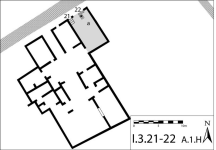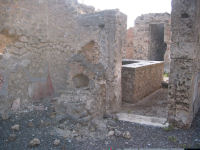
Figure 16: Bar at I.3.21-22, Pompeii.

Figure 16: Bar at I.3.21-22, Pompeii.
Eleven of the Type A.1 properties - 9% of all Type A, and 44% of all Type A.1 - retained access to an attached house via an open doorway. It is of course not possible to determine whether such doorways were shut or left open, permanently locked or frequently passed through. These doorways often belonged to an earlier spatial relationship, when the space operated differently, for example, as a domestic space attached to a courtyard of a house. Indeed, seven of the eleven Type A.1.H properties were formerly so-called cubicula. VI.13.17 was converted from a rear room of the house at VI.13.16, its separation further emphasised by the blocking of visual access (i.e. the blocking of a window) to the garden located directly behind it. In other cases other parts of some Pompeian houses were converted to retail outlets, including the property at I.3.21-22 (Figure 16), which may have once been a side garden or open space accessible from the atrium of I.3.19-20, and the property at VI.10.3, where a front room adjacent to a side fauces leading to the courtyard was converted into a bar. While in most of these houses the part converted was that most easily accessible from the street, in others the complete house was given over to retail and commercial space (VI.2.5).

Figure 17: The counter at IX.7.24-25, Pompeii, probably operated in conjunction with the hearth in the adjacent courtyard.
It seems plausible that a number of resources and facilities were shared between the food and drink outlets and the houses to which they were attached. The two bars, at I.4.3 and at IX.7.24-25 (Figure 17), were likely to have used the cooking hearths located in the central courtyards (atria) of their attached houses. Foss (1994, 186) followed Niccolini (1854-1896, Vol II, 79) in believing that the bar at I.4.3 shared the use of the cooking facility, located in the adjacent atrium, with the members of the household.
Access to other resources that were common to both the bar and the adjacent house includes access to water supplies and to the storage of commodities and equipment, though access to the latter is less detectable because of the insufficient finds record. Nevertheless, the phenomenon of shared facilities is surely reflected in the average sizes of Type A.1.H bars. The smallest of any Type A food and drink outlet, the Type A.1.H properties, average just 22m². The largest of these was that at I.3.21-22 (see Figure 16), at 37m², while both I.4.3 and IX.7.24-25 (Figure 17) were each 13m². A comparison with the average size of Type A.1 properties, at 26m², suggests the sharing of facilities and resources must have compensated for the lack of space given over to the retail activities of Type A.1.H bars. A comparison of the average size of Type A.2 bars with A.2.H, as will be mentioned in the following section (see Figure 21 and Figure 22), shows a similar relationship.
© Internet Archaeology/Author(s)
URL: http://intarch.ac.uk/journal/issue24/4/6.1.2.html
Last updated: Mon Jun 30 2008